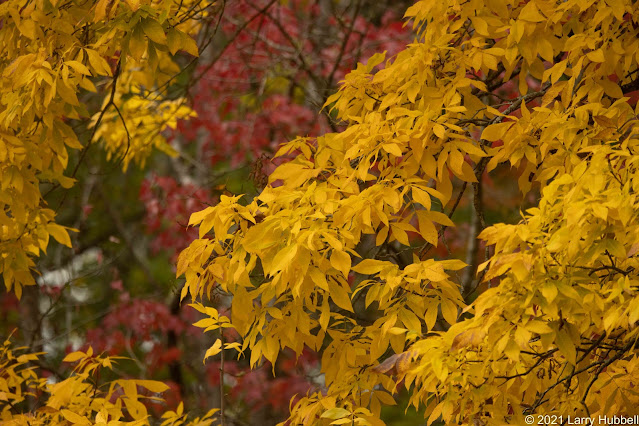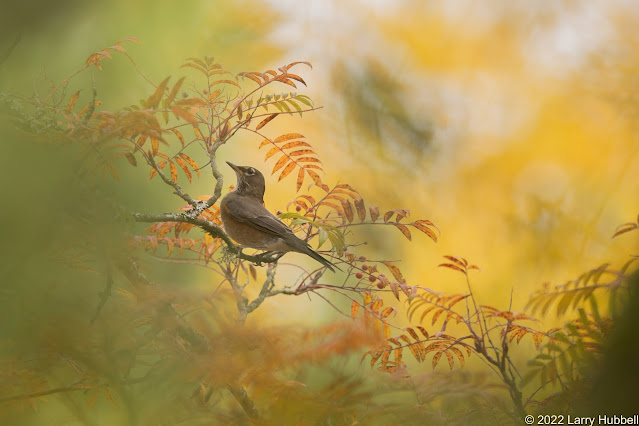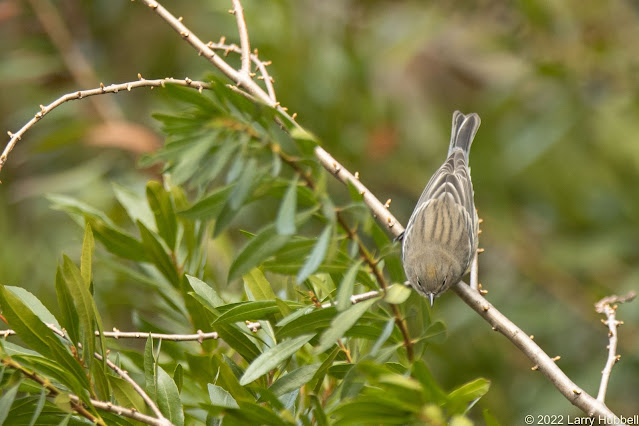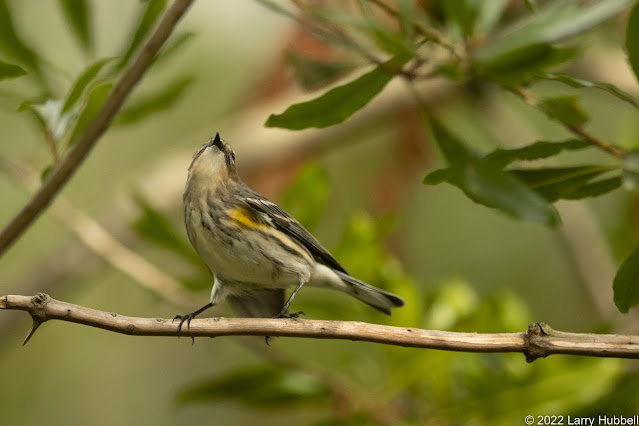The Fall provides an ephemeral beauty. One moment the leaves are bursting with color and the next they are on the ground, turning brown, replenishing the soil and providing food, shelter, and warmth for a variety of small creatures. Leaves tend to follow a fairly fast path around the circle of life. Fruits and nuts also fall from trees but they have the potential for much longer lives. I find it mind-numbing to wonder how many times a seed molecule might become part of a new tree, and then be transferred again into a new seed and then into another tree, and so on. Surely, the odds are slim for this process to be repeated infinitely, but it seems technically possible.
However, the seeds in most fruit do not become trees. Often when the fruit is consumed by other species, the seeds do not land in a fortuitous location, and the fruit molecules involved take a much shorter ride along the swifter side of the circle of life.
This post focuses primarily on some of our local fruit-eating birds. Not only do they help enable the life cycles of fruit trees, but their own lives, and life cycles, are also enabled by the fruit they consume.
In this post, your challenge is to determine which of the six bird species shown are frugivores.
Note: For our purposes, any birds that eat fruit are frugivores. It does not matter if they are part-time fruit eaters - since fruit is seasonal this is the most likely situation.
All six species have been photographed near fruit in the last month.
Some are common birds.
Some are not seen so often.

Of the species shown above, three belong to the Thrush (Turdidae) family, two are Warblers (Dendroica) and one is a Waxwing (Bombycilla). All are winter residents in our area. (For the advanced birders a secondary challenge is, Which of these species does not breed locally?)
In the same order they were presented the six species are:
1. Varied Thrush
2. Townsend's Warbler
3. Cedar Waxwing
4. American Robin (also a Thrush)
5. Hermit Thrush and
6. Yellow-rumped Warbler
To be totally open and consistent it is the foods listed for each species in
All About Birds that have been used to objectively determine whether we consider them frugivores.
Your primary challenge is to determine from memory which of these species are not known to eat fruit. You should make your mental list before proceeding.
*******************
Spoiler Alert!
The following photos will show many of these species eat fruit.
*******************
American Robins are the most commonly seen of these Fall frugivores.
In the Spring, you will often see them sporadically sprinting across lawns, sometimes stopping to listen, and then snagging, stretching, and securing worms, to take to their young.
Their similarly-sized cousins, the Varied Thrush, tend to raise their young in forested areas. In the Spring, while American Robins may be searching for worms in Western Washington cities, Varied Thrush are more likely to be found in the forests of the Olympic or Cascade Mountains, looking through the leaf litter for insects.
In the Fall, some of them come to the cities. However, they are bashful. When you find a fruit tree full of feeding Robins look closely at the birds on the far side of the tree, sometimes, you may see a Varied Thrush.
In the same Fall fruit trees, small flocks of Cedar Waxwings can occasionally be found.
It is obvious they are attracted to the fruit, but how they decide when and where to feed is a mystery to me. Unlike the Robins, they are not likely to feed until the fruit is gone. On the whole, they feed more briefly, return less frequently, and flock more tightly.

Of the three Thrush mentioned the Hermit Thrush, true to its name, is the least likely to be seen. It is also the smallest in size and roughly three times smaller in weight. Visually, they are closer in size to Song Sparrows than to the other two Thrush. However, their shape is clearly quite similar to their larger cousins.
Their size has a logical impact on where they can be seen. Since Thrush prefer to eat fruit whole they tend to be found feeding in trees with the smallest of fruit.
Curiously, Cedar Waxwings are similar in weight to the Hermit Thrush, but they appear to be able to eat larger fruit. Their bills seem longer and apparently able to open wider. They may be just better adapted as frugivores.
The last frugivore in our group may be the most surprising of all, the Yellow-rumped Warbler. By weight, they are about half the size of the average Hermit Thrush. (On the other hand, they can be as much as fifty percent larger than the Townsend's Warblers - which is the only other winter Warbler found in Western Washington.)
Yellow-rumped Warblers have the ability to process and eat the fruit of Wax Myrtles.
This ability is such a specific adaptation and preference that the white-throated variety of the Yellow-rumped Warbler is named the Myrtle subspecies.
In conclusion, while the tiny Townsend's Warbler may search for food in fruit-bearing trees, it is actually the only one of our six species that, per All About Birds, is not mentioned as a fruit-eater.
In answer to the other, earlier question, the Hermit Thrush is the only one of the six species not known to breed in Western Washington per the
All About Birds range maps.
Have a great day on Union Bay...where nature lives in the city and Black Birders are welcome!
Sincerely,
Larry
Going Native:
Each of us, who breathes the air, drinks water and eats food should be helping to protect our environment. Local efforts are most effective and sustainable. Native plants and trees encourage the largest diversity of lifeforms because of their long intertwined history with our local environment and native creatures. Even the microbes in the soil are native to each local landscape.
I hope we can inspire ourselves, our neighbors, and local businesses to respect native flora and support native wildlife at every opportunity. I have learned that our most logical approach to native trees and plants (in order of priority) should be to:
1) Learn and leave established native flora undisturbed.
2) Remove invasive species and then wait to see if native plants begin to grow without assistance. (When native plants start on their own, then these plants or trees are likely the most appropriate flora for the habitat.)
3) Scatter seeds from nearby native plants in a similar habitat.
4) If you feel you must add a new plant then select a native plant while considering how the plant fits with the specific habitat and understanding the plant's logical place in the normal succession of native plants.
***************
My friend Elaine Chuang shared several resources (that were new to me) from the January 2022 Washington Ornithological Society meeting. By the way, Elaine credits Vicki King for researching and supplying this information. Keystone native plants are an important new idea. Douglas Tallamy in the book "Nature's Best Hope " explains that caterpillars supply more energy to birds than any other plant eater. He also mentions that 14% of our native plants, i.e. Keystone Plants, provide food for 90% of our caterpillars. This unique subset of native plants and trees enables critical moths, butterflies, and caterpillars that in turn provide food for the great majority of birds, especially during the breeding season.
Here are the top two relevant links.
A video all about native keystone plants for wildlife:
https://www.youtube.com/watch?v=O5cXccWx030
New! Updated resources for adding keystone native plants to your yard.
https://wos.org/wos-wp/wp-content/uploads/2022/10/Native-Plant-Resources-10-7-22.pdf
This updated collection includes a variety of new and different books, perspectives, and interactions between plants, birds, and insects. Thank you to Vicki King for continuing to collect all of these exceptionally helpful works. Also, thank you to each of the individuals who contributed.
***************
In the area below it is my intention to display at least one photo each week to help challenge us to know the difference between native and non-native lifeforms.
What type of tree is this? Is it native to our area?
Scroll down for the answer.
******************
Pacific Madrone: Yes, this tree is native to the West Coast. It is our only native, broad-leafed, evergreen tree. Its fruit attracts a variety of birds and the hardwood of its dead branches and snags is utilized by a variety of cavity-nesting birds to create enduring and easily recycled nest sites.
*****************
The Email Challenge:
Over the years, I have had many readers tell me that Google is no longer sending them email announcements. As of 2021, Google has discontinued the service.
In response, I have set up my own email list. With each post, I will manually send out an announcement. If you would like to be added to my personal email list please send me an email requesting to be added. Something like:
Larry, Please add me to your personal email list.
My email address is:
LDHubbell@comcast.net
Thank you!
*******************
The Comment Challenge:
Another common issue is losing your input while attempting to leave a comment on this blog. Often everything functions fine, however, sometimes people are unable to make it past the robot-detection challenge or maybe it is the lack of a Google account. I am uncertain about the precise issue. Sadly, a person can lose their comment with no recovery recourse. Bottom Line: If you write a long comment, please, copy it before hitting enter. Then, if the comment function fails to record your information, you can send the comment directly to me using email.My email address is:
LDHubbell@comcast.net
Sincerely,
Final Photos:
Yellow-rumped Warblers, weighing half an ounce or less, may be one of Union Bay's smallest Frugivores.







































